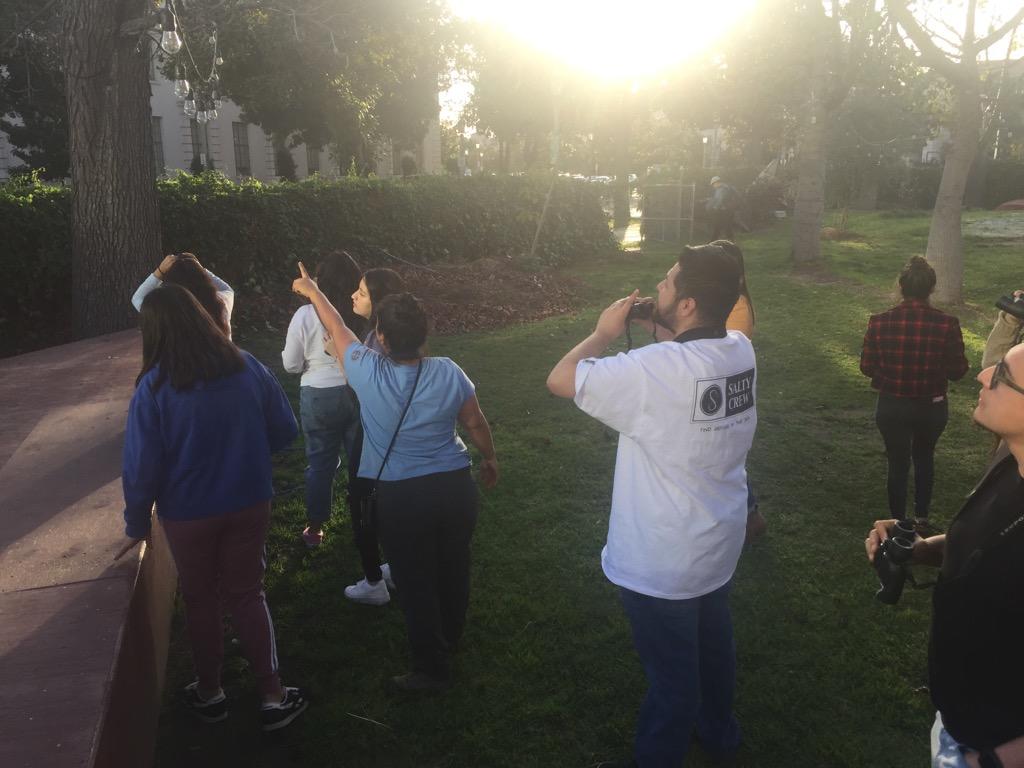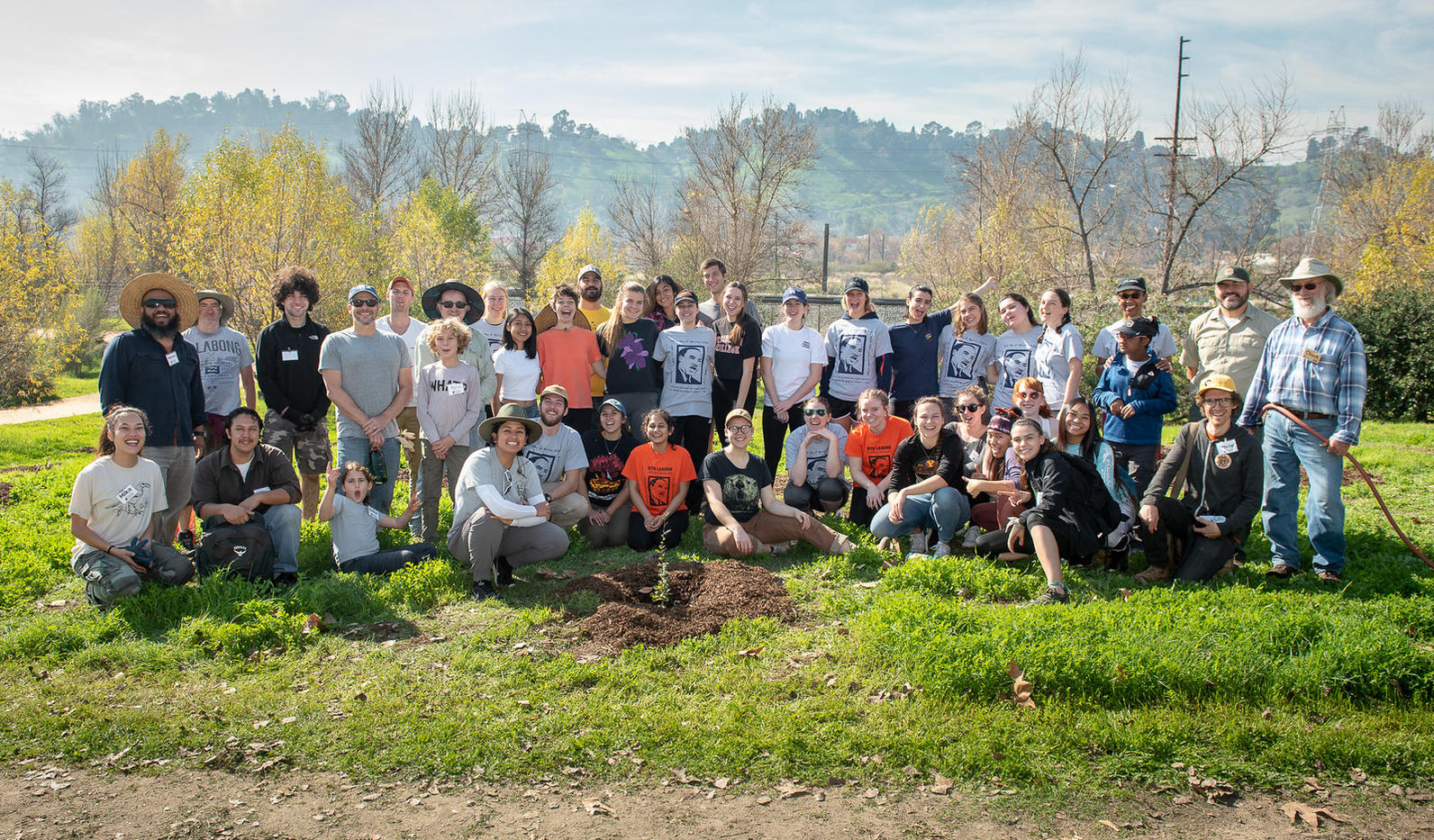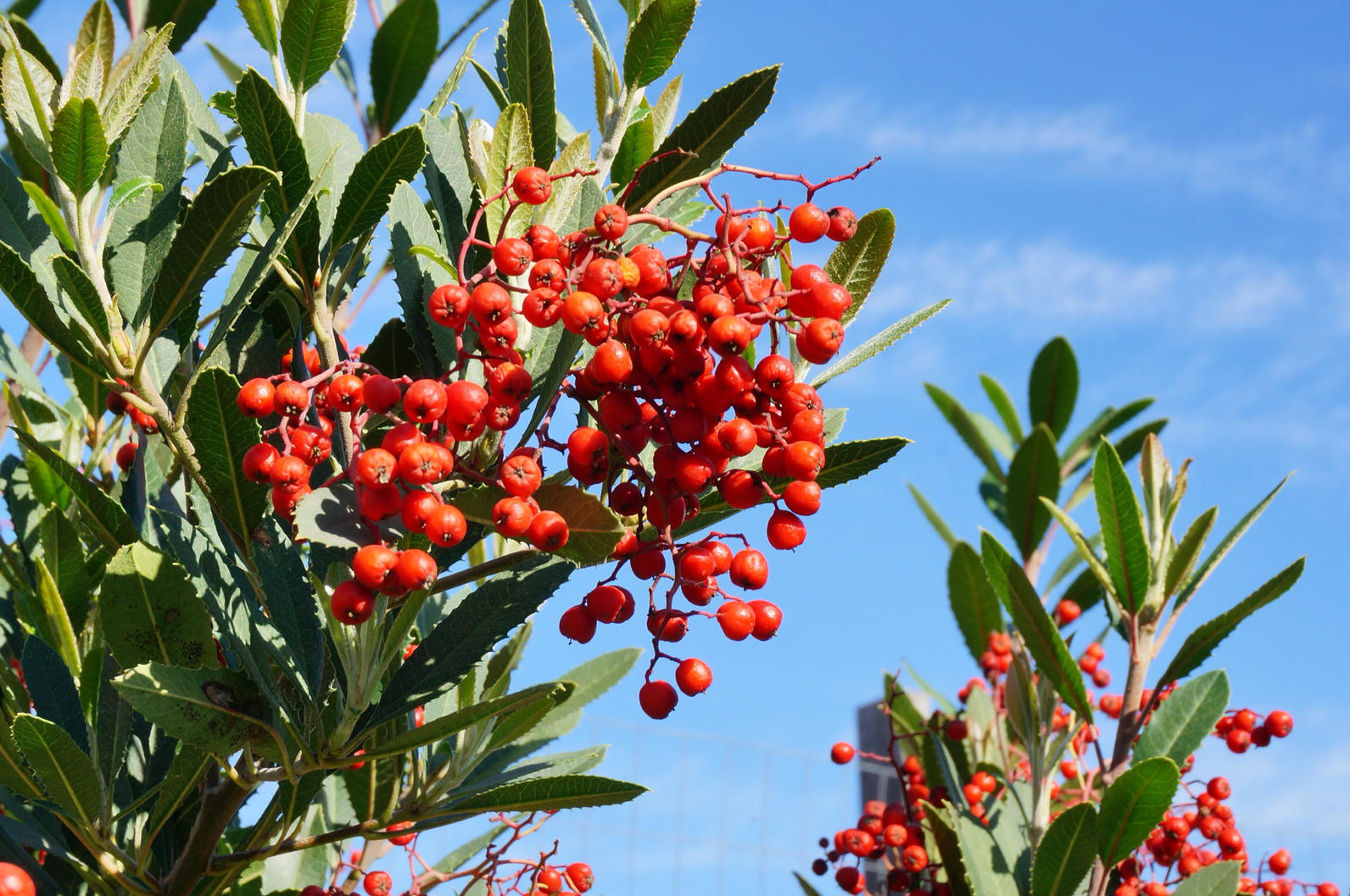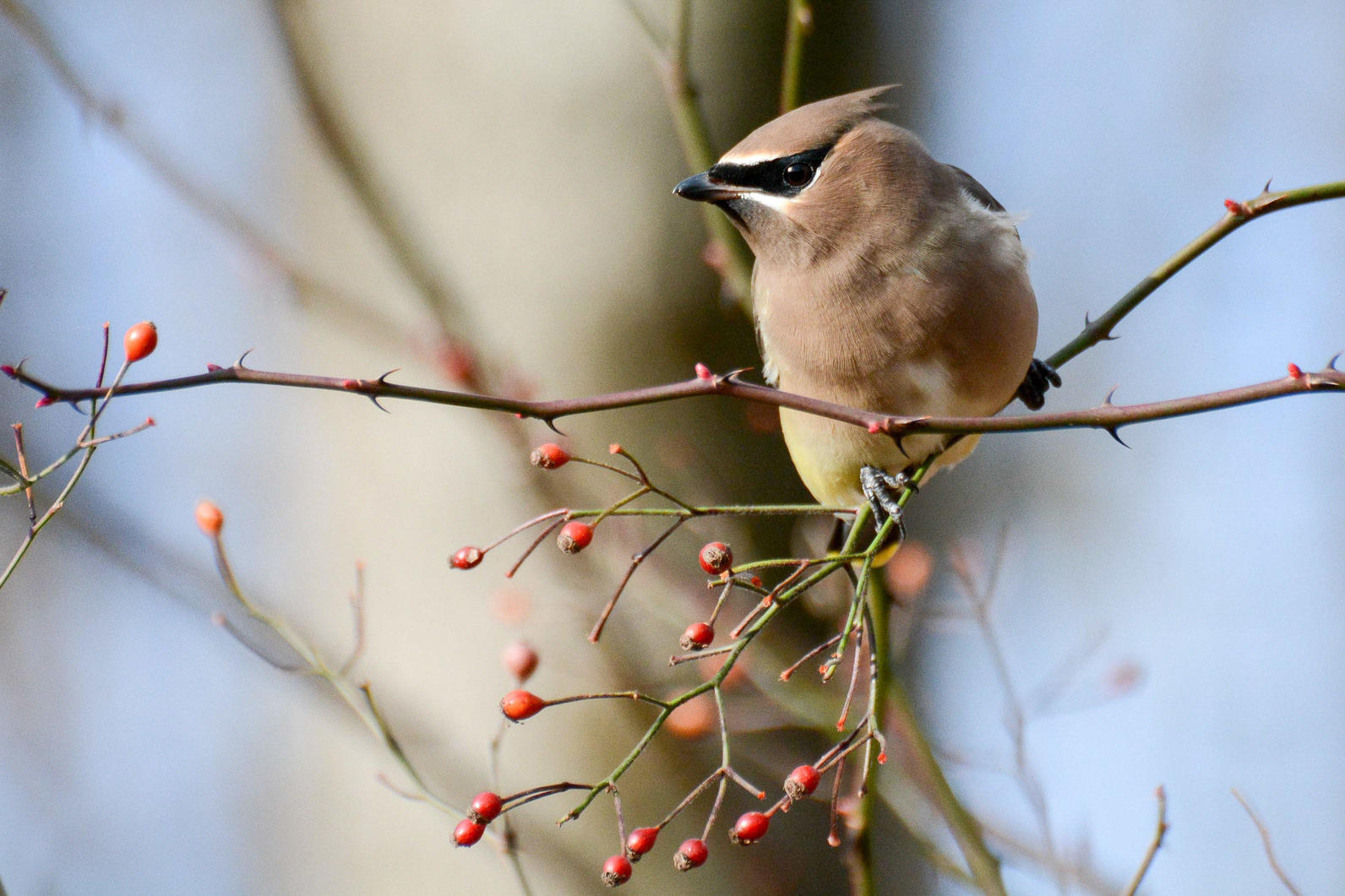
On February 26th, the Audubon Center at Debs Park teamed up with Day One to teach local youth more about our favorite topic – BIRDS! Day One is a local nonprofit organization based out of Pasadena that focuses on youth engagement and fostering healthy habits. We are excited to partner with Day One in their Youth Advocate/Leadership Program which trains middle school, high school, and college students how to be positive role models, ambassadors for healthy lifestyles, and informed, engaged members of their communities. Each week, the Youth Advocate/Leadership group meets with different local organizations to learn about community engagement and advocacy.
ACDP staff met with 16 local students to talk about all things bird and birding. We started with a quick Birds 101 lesson where we talked about the defining characteristics of birds (all birds have wings, feathers, a beak, a specific bone structure, and lay eggs). We talked to students about “flyways” or the paths birds take during migration, migration and why birds migrate, and we explained the difference between resident birds vs. migrants (year-long inhabitants of a region and birds that migrate during winter/spring).
The students got a short binocular lesson and then we headed outside. Our staff talked about how once we start looking closer, we see that birds really are all around us! Just in Day One’s yard in Downtown Pasadena, we saw lots of activity including Allen’s Hummingbirds, Mourning Doves, White-throated Swifts, and Yellow-rumped warblers at dusk! It’s important to pay attention to what birds we see because each tells its own story about climate change.

We talked to students about the connections between birds and climate change and the importance of taking action to protect habitat for birds and people. One of the easiest and most beneficial things you can do is planting California native plants in your backyard or local park. These plants crate bird-friendly habitat and mitigate the negative effects of climate change.
We are excited for our partnership with the Day One Youth Advocate/Leadership Program and look forward to connecting with their youth more in the future.
Read more about Day One’s Youth Advocate/Leadership Program here.
Read more about the National Audubon Society’s Plants for Birds Program here.

On Saturday, February 1st, Center Director Marcos Trinidad led a bird walk along the LA River. Around 10 birders from the community came to check out he avian action along the LA River. We started our walk at the Lewis MacAdams Riverfront Park and headed upstream. Along the way, birders were able to catch a glimpse of some cool birds including red breasted merganser, an osprey, belted kingfishers, and black-throated gray warblers.The highlight of the day was getting a rare peak at the osprey behavior along the river. We caught a sight of an osprey flying around and going into the water and taking a short bath before flying back to its perch.
Many of the birds we see along the LA River use the river as a stop over site in their migration to their breeding sites up north. The LA River serves as a rest stop for these birds to munch, rest, and refuel before their long trip back north.

Our bird walks along the LA River provide a great opportunity to learn about shorebirds and other birds who call the LA River home. Join us on the first Saturday of every month along the LA River and increase your bird knowledge!
Our next LA River Bird Walk will be on March 7th starting again at the Lewis MacAdams Riverfront Park. We hope to see you there!

Have you event wondered how the Center grounds stay so clean and well-maintained? Well, the answer is Choix Vocational Services and their team of experienced volunteers who come out every Tuesday, Wednesday, and Thursday morning to help ensure that the Center is looking its best. Choix volunteers support with sweeping, raking, trash pickup, refilling our bird feeders, and more. They have perfected their cleanup process and know exactly how to divide and conquer upon arrival, so that they are able to get the job done in the most efficient and effective manner possible. Choix volunteers play an essential role in creating a welcoming environment for visitors and without them the Center would not look nearly as nice and serene as it does. We are so grateful for their partnership and dedication, and truly could not do it without them. Next time you see Choix volunteers around, please tell them a huge THANK YOU for all that they do!
Choix Vocational Services a non-profit 501(c)(3) organization that provides supports and services to individuals with developmental disabilities through its facility in East Los Angeles and throughout the local and neighboring communities. Choix Vocational Services embrace the philosophy that any individual, regardless of the extent of his disabilities, is capable of participating and contributing to his community when the appropriate supports are provided.

There are lovers and there are fighters, and well, the Red-tailed hawk is both. This bird of prey is a Debs Park favorite – look up and you’ll often find pairs soaring around in the sky taking advantage of the thermal uplift. If you don’t think you’ve seen one, you’ve definitely heard one. Their call has been used in movies and TV as the “generic raptor sound” – even when the bird featured isn’t actually a red-tailed hawk. Red-tailed hawks are lovers at heart. Like many raptor species, they are monogamous. Once they find a mate, most pairs stay together for life (although, break-ups are not necessarily uncommon). Pairs can often be seen soaring and hunting together. Red-tailed hawks are carnivorous and highly opportunistic feeders – their most common prey are small mammals such as rodents, but they’re also known to eat fish, reptiles, and invertebrates. Come to Debs and watch these love birds dancing in the sky!

Coyote Bush also called coyote brush, is one of our California native shrubs that you not only find in California, but also Oregon and Baja California. This shrub is in the asteraceae family, or the daisy family. It's actually in the same plant family as the sunflower (althought it doesn't look like it!). If you pay close attention to the remnants of its flower and seed you might be to see why it belongs in the daisy family. The seeds of this plant are similar to a dandelion seed: fluffy and light. This fluffiness and lightness allow the seeds to be dispersed by air, making this plant one of the easiest native plant to tend and spread. Like other native plants, this native shrub provides optimal bird food through it’s seeds. Lesser Goldfinches are favorites of this plant along with other sparrows such as our White-crowns and California Towhees. Come check out this plant at Debs!

On January 25th, the Audubon Center at Debs Park celebrated the MLK Day of Service in our favorite way – building sustainable habitat for birds with our community! 37 community members, including students from Occidental College, joined us for a habitat enhancement volunteer event at the Rio de Los Angeles State Park.
We’ve been working at the Rio de Los Angeles State Park in partnership with California State Parks Foundation and the Gottlieb Native Garden to create bird-friendly habitat around the wetlands area of the park. The Rio de Los Angeles State Park has an active community that participates in active recreation (running and playing sports) as well as passive recreation (walking and birdwatching). Community members can also hike along the wetland habitat at Rio, and peek at what native habitat looks like along the LA River.

During the MLK Day of Service event, we maintained California native plants that had been planted in December including Coast live oak and California black walnut trees. This included weeding and mulching around these plants, and watering (oaks and walnuts require lots of water in their first couple of years!). Thanks to the weather, we were also able to plant! Volunteers planted over 30 California native plants including black sage, California buckwheat, and California bush sunflower. These plants will grow and serve as habitat and food for the local bird population.
At the end of the event, volunteers were treated to the sight of Arroyo lupine growing everywhere. We’re looking forward to the spring when they’ll bloom and provide fragrance for the whole restoration site!

We’ve loved working at the Rio de Los Angeles State Park for the past couple of months and we’re looking forward to continuing our work there with the community! Join us for community volunteer events every 4th Saturday of the month from 9AM – 12PM or for our upcoming events on February 15th and February 22nd.
Read more about the history of the MLK Day of Service here!

Our native plant for the month of December is no other but a perennial shrub filled with red berries every winter: Toyon. This plant is a prominent component of the coastal sage scrub community and is commonly referred to as Christmas berry and California Holly. In fact, Hollywood was named after this plant since it was mistaken for Holly, so Hollywood should really be named Toyonwood. This native shrub provides prime bird food during the cold winter months through their bright red berries. Flocks of Cedar Waxwings frequent our park during this time of year thanks to this native plant. Toyon berries are not only eaten by birds however. Toyon berries can also be eaten by people, although we do not recommend ingestion unless you are familiar with the plant. Our local indigenous population, Tongva are experts on this plant (along with all our other native plants) and would use this plant as food and branches to make toys or instruments. Come check out our park and the beauty of the Toyon during this month!

December is a time known for holidays and coming together in community for eating and laughter, and it seems like even Cedar Waxwings know that. Cedar Waxwings are known to travel in flocks are highly sociable birds making it rare to only see one Cedar Waxing; where there is one, there are more. Aside from traveling in flocks, these birds are known for their waxy red and yellow tips on their flight feathers, hence their name. These birds are also huge fans of Toyon during this time of year and you will constantly see them around the park feasting on the bright red berries. If one gets lucky, you might even catch them perched on a branch in a line passing a berry back and forth. Majority of their diet is consisted of berries and small fruit, and food availability is so important that their migration can be dependent on food supply. Come check out some binoculars at Debs and see if you catch these birds around!

Have you ever seen a group of people running around Debs Park on a Saturday morning with gloves and plastic bags and wondered, what the heck are those people doing? Well, the answer is plogging! Plogging, which is a combination of jogging and picking up trash, originated in Sweden a few years back and has since spread throughout the U.S. in response to concern surrounding plastic litter and pollution. For those of you who have driven or walked along the roads surrounding Debs Park, we’re sure you have noticed the significant need for trash pickup in this area. Back in 2018, volunteers Michelle Tarian and Tyler Locke identified this need and decided to take action. They spearheaded a partnership with L.A. Works aimed at bringing ploggers out to Debs Park and ran a number of successful events, collecting hundreds of pounds of trash. The project has now been taken over by two new volunteers, Alma Lerma and Kevin Gerner, who are currently leading plogging events almost every other Saturday here at the Center. We couldn’t be more grateful for Michelle, Tyler, Alma, and Kevin’s generous donation of time and energy towards keeping the park clean, preventing plastic pollution, and engaging the community in stewardship of Debs Park. We’d like to extend a huge thank you to these superstar volunteers, and to everyone who has already participated in a plogging event!
We can’t think of a better way to start your Saturday morning than by spending time outdoors, getting your exercise in, and meeting new people, all while picking up trash and beautifying our local greenspaces. Sign up for an upcoming plogging event HERE! And in the meantime, check out this Spectrum news clip for more information on Debs Park plogging and follow @plogginglosangeles for updates and upcoming events!

The holiday season is in full swing here at the Audubon Center at Debs Park and we were super excited to celebrate with our annual Native Plant Wreath-Making Workshop! On Saturday, November 23rd, we invited our community to participate as part of our Nature Arts + Crafts Series. This workshop is one of our favorite holiday traditions to share with our community because it gives us a chance to introduce people to California native plants and it also gives us an opportunity to make holiday memories together!
Many families came to the Audubon Center at Debs Park to make holiday wreaths together under the pepper tree with the wonderful sound of the Old Time String Jam Band in the background. We loved teaching people about the different plants being used to make these wreaths. Our staff was amazed by the creative ways our community used native plants to make wreaths of all sizes!

Interested in the plants we used and why? Our holiday wreaths are made with a base of pepper and eucalyptus tree branches. If you’ve visited the Center, you might recognize California Pepper Tree, which ironically is not a California native! We also used eucalyptus tree branches – invasive trees originally from New Zealand and Australia. Their leaves have a great scent and some of them have beautiful white berries that looked beautiful on the holiday wreaths. Both the California pepper tree and eucalyptus have branches are pliable which make for a good base. Because these serve as the base, they made up the majority of the plants we cut back from our trails.
We used California native plants to fill and decorate our native plant wreaths. Some of the plants we included are:

This is by far the most festive plant at the Center. When the winter begins, toyon sprouts beautiful red berries. Toyon actually goes by the name of “Holly wood” because of its similarity to the traditional holly plant. During the winter, you’ll see many of the plants at the Center go dormant except for toyon.

Sugar bush is another evergreen plant you’ll still see blooming at the Center. They have reddish-pink branches giving them a festive appearance. At the end of each branch, you can see pink-cream flower clusters that added dimension to the wreaths.

Part of the same family as sugar bush, lemonade berry is another great addition to a native plant holiday wreath. During the winter, the orange and pink flower clusters of lemonade berry stay shut, but look beautiful in any wreath!
Do you love the holidays as much as we do? Don’t miss our Christmas Bird Count on Saturday, December 21st!
Audubon Center at Debs Park is located at 4700 Griffin Ave, Los Angeles, CA 90031
Center Hours:
Trail Hours:
You can help us continue to deliver this outstanding programming to the Los Angeles area by making a generous gift today. Thank you!